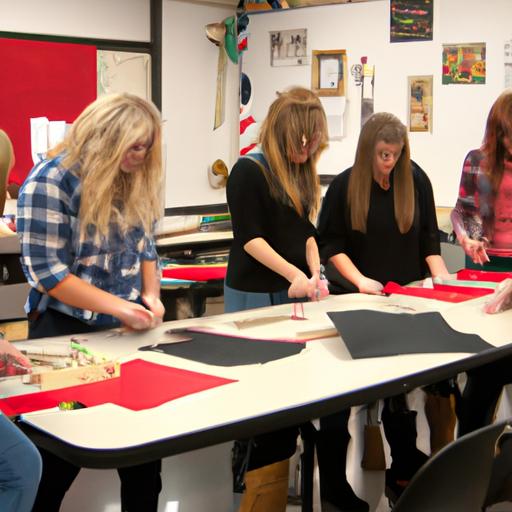Fine arts in college encompass a diverse range of creative disciplines that allow individuals to express their artistic talents. This article aims to explore the definition of fine arts in college and shed light on the importance of pursuing an education in this field.
Definition of Fine Arts in College
Fine arts in college refer to academic programs and courses that focus on various artistic disciplines such as visual arts, performing arts, and more. It is a comprehensive study that encourages students to explore their creativity, develop technical skills, and gain a deeper understanding of art’s cultural significance.
Importance of Fine Arts Education
The significance of fine arts education cannot be overstated. It not only nurtures creativity but also fosters critical thinking, problem-solving, and communication skills. Fine arts education encourages individuals to think outside the box, challenging societal norms and perceptions. By engaging in artistic expression, students develop a unique perspective that enhances their overall educational experience.
Moreover, fine arts education plays a vital role in cultural preservation and appreciation. It allows individuals to explore different art forms, historical contexts, and cultural backgrounds, fostering a deep appreciation for diversity. Through studying fine arts, students become more aware of the world around them and are better equipped to contribute meaningfully to society.
In an increasingly digitized world, the value of fine arts education remains relevant. It cultivates skills that cannot be easily replicated by technology, such as imagination, emotional intelligence, and personal expression. These skills are highly sought after in various industries, including advertising, design, entertainment, and more.
In conclusion, fine arts in college encompass a broad range of artistic disciplines, providing students with a platform to explore their creativity and develop essential skills. The importance of fine arts education lies in its ability to nurture imagination, critical thinking, cultural appreciation, and career opportunities. So, let’s delve deeper into the history, disciplines, benefits, and programs associated with fine arts in college.
History of Fine Arts Education in College
A. Evolution of Fine Arts Programs
The history of fine arts education in college dates back centuries, with its roots deeply embedded in the pursuit of knowledge and artistic expression. Over time, the evolution of fine arts programs has shaped the way we perceive and appreciate art in academia.
In ancient Greece, the concept of arts education emerged with the belief that artistic endeavors were integral to a well-rounded education. The Renaissance era witnessed a revival of interest in the arts, leading to the establishment of academies and schools dedicated to training aspiring artists. These institutions laid the foundation for formalized fine arts education.
During the 19th and 20th centuries, the industrial revolution and technological advancements influenced the direction of fine arts programs. Traditional techniques were combined with new mediums, resulting in the emergence of modern art movements such as Impressionism, Cubism, and Abstract Expressionism. Fine arts education adapted to these changes, embracing experimentation and encouraging students to push the boundaries of artistic expression.
B. Contributions of Fine Arts to College Education
Fine arts education goes beyond teaching technical skills and artistic techniques. It offers a multitude of contributions to college education, enriching students’ overall learning experience.
-
Creativity and Critical Thinking: Fine arts education nurtures creativity and encourages students to think critically. Through artistic exploration, students learn to interpret, analyze, and solve problems in innovative ways. These skills are transferable to various academic disciplines and real-world scenarios.
-
Cultural Awareness and Expression: Fine arts education promotes cultural appreciation by exposing students to diverse art forms, historical contexts, and global perspectives. It encourages individuals to explore and express their own cultural identity, fostering a sense of inclusivity and empathy.
-
Interdisciplinary Collaboration: Fine arts education often involves collaborations with other disciplines, such as science, technology, and social sciences. This interdisciplinary approach encourages students to think beyond traditional boundaries and find unique solutions through the integration of different perspectives.
-
Personal Growth and Self-Expression: Fine arts education provides a platform for personal growth and self-expression. It allows students to explore their emotions, beliefs, and experiences, fostering self-awareness and confidence. This personal development extends beyond the boundaries of the art classroom, positively influencing other aspects of students’ lives.
In conclusion, the history of fine arts education in college showcases its evolution from ancient civilizations to modern times. The contributions of fine arts to college education are far-reaching, encompassing creativity, critical thinking, cultural awareness, interdisciplinary collaboration, and personal growth. As we move forward, let’s delve into the various disciplines within fine arts and the benefits they offer to students.
Various Disciplines in Fine Arts
Fine arts in college encompass a wide range of disciplines, allowing students to explore and specialize in their areas of interest. Let’s delve into two primary categories of fine arts: visual arts and performing arts.
A. Visual Arts
Visual arts involve creating artwork that can be seen, engaging the viewer visually. Within this discipline, students can explore various forms of artistic expression. Here are three popular branches of visual arts:
1. Painting
Painting is a medium that allows artists to express their creativity using brushes, paints, and other tools. From oil and acrylic to watercolors and mixed media, painting offers endless possibilities for self-expression. It allows artists to convey emotions, ideas, and narratives through color, texture, and composition.
2. Sculpture
Sculpture involves shaping and manipulating materials to create three-dimensional artworks. Artists work with various materials such as clay, wood, metal, or stone, breathing life into their ideas and concepts. Sculptures can be representational or abstract, and they often invite viewers to engage with the artwork from different angles.
3. Photography
Photography is a visual art form that captures moments, stories, and emotions through the lens of a camera. It offers a unique way to document the world around us, showcasing perspectives that may otherwise go unnoticed. Photographers experiment with lighting, composition, and subject matter to create captivating images that evoke emotions and convey messages.
B. Performing Arts
Performing arts involve live performances, showcasing talent and creative expression through movement, sound, and storytelling. Here are three prominent branches of performing arts:
1. Music
Music is a universal language that transcends cultural boundaries. It encompasses various genres and styles, providing a platform for musicians to express their emotions and connect with audiences. Whether through instruments or vocal performances, music has the power to evoke strong emotions and create memorable experiences.
2. Dance
Dance is a form of artistic expression that combines movement, rhythm, and storytelling. Dancers use their bodies to convey emotions, narratives, and cultural traditions. From ballet and contemporary to hip-hop and traditional folk dances, the art of dance captivates audiences with its grace, athleticism, and creativity.
3. Theatre
Theatre is a collaborative art form that combines acting, stage design, and storytelling. It brings characters, narratives, and ideas to life through live performances. Theatre productions encompass various genres, including dramas, comedies, musicals, and experimental works, enthralling audiences with their performances and thought-provoking themes.
In conclusion, fine arts in college encompass a diverse array of disciplines. Visual arts offer opportunities for self-expression through painting, sculpture, and photography. Performing arts, on the other hand, allow individuals to express themselves through music, dance, and theatre. Each discipline within fine arts provides unique avenues for creativity, exploration, and artistic growth.
Benefits of Studying Fine Arts in College
Studying fine arts in college offers a myriad of benefits that extend beyond the realms of artistic expression. Let’s explore some of the key advantages that come with pursuing a fine arts education.
Development of Creativity and Critical Thinking Skills
Immersing yourself in the world of fine arts nurtures and hones your creative abilities. Through various artistic disciplines, such as painting, sculpture, or music, you learn to think outside the box, pushing boundaries and exploring innovative ideas. The process of creating art encourages experimentation, problem-solving, and the ability to view situations from different perspectives. These experiences foster the development of creativity and critical thinking skills, which are invaluable in all aspects of life.
Enhanced Cultural Awareness and Expression
Engaging with different art forms exposes you to diverse cultures, histories, and belief systems. Fine arts education encourages individuals to appreciate and understand various artistic traditions, allowing for a deeper cultural awareness and sensitivity. By exploring and expressing ideas through art, you develop a unique voice and the ability to communicate complex emotions and concepts. Fine arts education provides a platform for self-expression, enabling you to share your thoughts, experiences, and perspectives with the world.
Potential Career Opportunities in Fine Arts
Contrary to common misconceptions, a fine arts degree opens doors to a range of exciting career opportunities. Graduates can pursue careers as professional artists, designers, curators, art educators, art therapists, and more. The skills developed during a fine arts education, such as creativity, critical thinking, and problem-solving, are highly valued in industries beyond the fine arts sector. Employers recognize the transferable skills gained from studying fine arts, making fine arts graduates well-equipped for a variety of career paths.
In conclusion, studying fine arts in college offers numerous benefits. It cultivates creativity and critical thinking skills, enhances cultural awareness and expression, and opens up diverse career opportunities. The advantages of a fine arts education extend beyond the artistic realm, making it a valuable and enriching experience for individuals passionate about creative expression.
Fine Arts Programs in Colleges
When considering pursuing a fine arts education in college, it is essential to understand the various degree options available. Let’s explore the degree programs in fine arts and gain insights into choosing the right college for your artistic journey.
Degree Options in Fine Arts
-
Bachelor of Fine Arts (BFA)
The Bachelor of Fine Arts (BFA) program is an undergraduate degree that provides students with a comprehensive education in their chosen artistic discipline. This degree typically offers a specialized curriculum that focuses on honing technical skills, artistic expression, and critical thinking. Students pursuing a BFA can choose from various areas of specialization, including painting, sculpture, photography, music, dance, and theater. A BFA degree is often considered a foundation for further studies or a pathway to entry-level careers in the arts.
-
Master of Fine Arts (MFA)
The Master of Fine Arts (MFA) program is a graduate-level degree that offers advanced training and specialization in a specific artistic discipline. This program is designed for individuals who wish to deepen their artistic practice, refine their skills, and pursue a career in the arts or academia. The MFA program typically involves intensive studio work, research, and critical analysis. It offers opportunities for students to collaborate with experienced artists, engage in artistic research, and exhibit their work. An MFA degree is highly regarded and can open doors to advanced career opportunities, such as teaching positions, gallery representation, and artistic residencies.
Choosing the Right College for Fine Arts Education
Selecting the right college for your fine arts education is a crucial decision that can greatly impact your artistic journey. Here are some factors to consider when choosing a college:
-
Accreditation: Ensure that the college or university you choose is accredited by recognized accrediting bodies. Accreditation ensures that the institution meets specific quality standards and that your degree will hold value in the professional world.
-
Faculty and Facilities: Research the faculty members in the fine arts department. Look for experienced and accomplished artists who can provide mentorship and guidance. Additionally, assess the facilities available, such as studio spaces, equipment, and exhibition opportunities. These resources play a vital role in your artistic growth and development.
-
Curriculum and Specializations: Evaluate the curriculum offered by the college. Look for a program that aligns with your artistic interests and goals. Consider the range of specializations available and the flexibility of the curriculum to tailor it to your specific artistic path.
-
Alumni Success and Industry Connections: Explore the success stories of alumni from the college. Consider their achievements, the recognition they’ve received, and the opportunities they’ve gained. Additionally, assess the college’s industry connections, such as partnerships with galleries, museums, and performance venues. These connections can provide valuable networking opportunities and exposure to the professional art world.
By carefully considering these factors, you can make an informed decision when choosing the right college for your fine arts education. Remember, finding a college that aligns with your artistic vision and offers opportunities for growth and exploration is essential for a fulfilling educational experience.
Conclusion
In conclusion, understanding what fine arts in college entails is crucial for those seeking to pursue their passion for creativity and self-expression. Fine arts education in college offers a diverse range of disciplines, allowing individuals to explore visual and performing arts.
Throughout history, fine arts education has evolved and contributed significantly to college education. It has provided a platform for students to develop their artistic skills, critical thinking abilities, and cultural awareness. The various disciplines within fine arts, such as painting, sculpture, music, dance, and theatre, offer unique avenues for self-discovery and personal growth.
Studying fine arts in college offers numerous benefits. It fosters creativity, enabling individuals to think outside the box and approach problem-solving from innovative perspectives. Additionally, fine arts education enhances cultural awareness and expression, promoting a deeper understanding of diverse art forms and historical contexts. Furthermore, pursuing a career in fine arts is a viable option, with opportunities in fields such as design, advertising, entertainment, and more.
When choosing a college for fine arts education, it is essential to consider the available degree options, such as a Bachelor of Fine Arts (BFA) or a Master of Fine Arts (MFA). Researching and selecting the right college that aligns with your artistic aspirations and offers a supportive environment is crucial for a fulfilling educational journey.
In conclusion, fine arts in college provide a unique avenue for individuals to explore their creative potential, expand their horizons, and develop skills that are highly valued in various industries. So, embrace the world of fine arts in college and unlock your artistic journey to express yourself and make a meaningful impact in the world.





